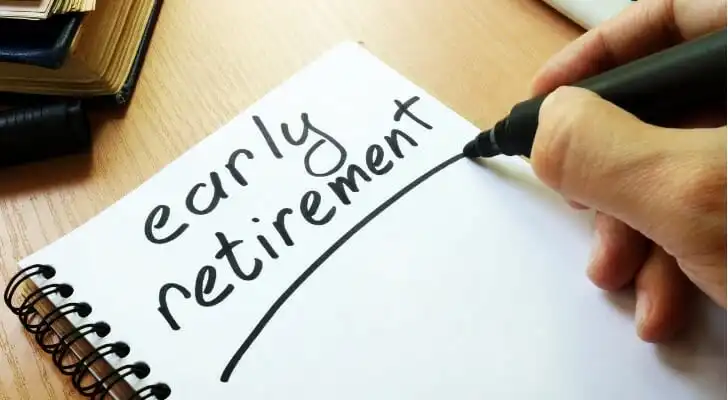Retiring at 45 might sound impossible. But with the right plan, it could be realistic. An early retirement means more time to pursue hobbies or passion projects, travel the world, volunteer or simply connect with friends and family. It’s what the Financial Independence / Retire Early movement is all about. But what does it actually take to retire at 45? This step-by-step guide can help you retire early with careful planning.
A financial advisor can help you put a financial plan together for your retirement needs and goals.
Step #1: Rethink Your Lifestyle
Graduating to your golden years by age 45 means the usual retirement saving and investing rules don’t apply. Unless you earn a very high income, you’ll likely need to adjust your lifestyle. That means rethinking how you live, spend, save and invest now so you can live, spend, save and invest the way you want to when you retire.
Start with a thorough budget review and identify any nonessential spending. Eliminating any non-mortgage debt, such as student loans, credit cards and car loans, helps too. Planning for early retirement may also require forgoing some of the “luxuries” you’re used to, such as eating out or engaging in hobbies.
Cutting these seemingly small expenses could make a big difference in reaching your goal. Ultimately, you’ll have to save more aggressively and invest more tactically to retire early. After all, the money you squirrel away by 45 will have to sustain you for the rest of your life.
Step #2: Get Clear on Your Retirement Vision
Next, define what retirement means to you. Again, that may involve traveling, exploring new hobbies, starting a business or even going back to school. The possibilities are limitless. But you’ll have to understand how much your vision will cost to develop a plan to get there.
Creating an estimated retirement budget will help you avoid shortfalls. Include all your basic living expenses. Then add other future costs, such as children’s education or rising health care expenses. These may increase with age. A retirement calculator can help you determine how much you need to reach your goal.
Step #3: Plan for Health Care Expenses
One of the biggest challenges of retiring at 45 is covering health insurance before you become eligible for Medicare at 65. That’s a 20-year gap you must include in your retirement plan. Without employer-sponsored health benefits, your options include a spouse’s health plan, private insurance through the ACA marketplace or a health care sharing plan.
Premiums for private coverage can be steep, especially as you age, so be sure to include them in your projected retirement budget. You may also want to open and fund a health savings account (HSA) while you’re still working. You can deduct contributions and withdraw funds tax-free when used for qualified health expenses — making it a powerful tool for managing early retirement medical costs.
Before making the leap, compare coverage options, forecast premiums, and build in a cushion for out-of-pocket expenses, including deductibles, prescriptions and unexpected procedures.
Step #4: Scale Your Income

Most people enter their peak earning years once they hit their 40s and 50s. If you’re planning to retire by then, you may need to pick up the pace with your earnings now.
There are different ways to approach this. You could ask for a promotion or raise at your current job or take on a part-time job. If those aren’t in the cards, you could start a side hustle or a small business as a way to increase your earnings. The higher your income, the more you can sock away for an early retirement. Your annual earnings also play into the length of time you’ll need to save and invest to meet your living expenses after 45.
And rather than living more lavishly as you earn a higher salary, focus on increasing contributions to your retirement accounts. You likely won’t miss the money in your paychecks since you are already living on less.
Step #5: Invest Strategically
Most investing experts agree that the younger you are, the more risk you can afford to take on. Theoretically, if the market tanks in your 20s or 30s, your portfolio would still have several decades to recover before you need to access the funds. Retiring early adds a wrinkle to that logic. If you know you want to retire by 45, you may want to take a more conservative approach to avoid jeopardizing your plan.
When adding investments to your portfolio, be sure to diversify. Also, factor in the fees you pay on each investment. Fees can nibble away at your returns over time so you should minimize fees wherever possible.
Remember, you won’t be eligible to collect Social Security until age 62 at the earliest. You’ll need to rely on other income sources during this stretch of time, including your investments. You also won’t be eligible to make penalty-free withdrawals from 401(k)s, IRAs and other tax-advantaged retirement accounts until age 59 ½.
Step #6: Manage Your Tax Liability
Investing for early retirement also means periodic rebalancing so you stay on track with your performance goals and harvesting your tax losses. Tax-loss harvesting means selling an asset that’s declined in value to counter the capital gains tax you might pay on a different investment that’s performed well.
You should also take advantage of tax-advantaged accounts. With traditional 401(k) plans and IRAs, your contributions are generally tax-deductible and withdrawals are taxed in retirement at your ordinary income tax rate. Roth IRA contributions, on the other hand, aren’t deductible. But you can make Roth IRA withdrawals tax-free beginning at age 59 ½. Contributions to an HSA are tax-deductible and withdrawals are tax-free when they pay for certain health care expenses.
Step #7: Plan for the Gap

Retiring at 45 has its perks but there is one major drawback: taking money from tax-advantaged plans prior to age 59 ½ could result in a 10% early withdrawal penalty. You may also face income taxes on the funds you withdraw.
Early withdrawals from a Roth IRA are an exception. If your account has been open for five years, you can withdraw original contributions at any time without taxes or penalties. But if you’ve been saving in a traditional IRA rather than a Roth, you’ll need another way to cover expenses.
Ideally, you have income-producing assets in your portfolio that you can draw from each month. You could also establish a taxable brokerage account, draw on cash savings or generate supplemental income through rental property investments.
Bottom Line
Timing matters for retirement. Someone who is beginning to save for retirement at age 25 may find it easier to retire by 45 versus someone who waits to start at 30 or 35. The best time to amp up your retirement strategy is always as soon as possible.
Tips for Achieving Early Retirement
- If you’re struggling with any of the above steps, you may want to consider working with a financial advisor. They will assess your current situation and help you determine what you need to do to retire by 45. SmartAsset’s free tool matches you with financial advisors who serve your area, and you can have a free introductory call with your advisor matches to decide which one you feel is right for you. If you’re ready to find an advisor who can help you achieve your financial goals, get started now.
- Be sure to factor Social Security benefits into your retirement income. You should also think about the right time to begin taking them. Technically, you could claim benefits starting at age 62. However, delaying benefits beyond your normal retirement age could increase your benefit amount. A Social Security calculator will estimate how much you can expect to receive in retirement benefits.
Photo credit: ©iStock.com/designer491, ©iStock.com/LaylaBird, ©iStock.com/artisteer
